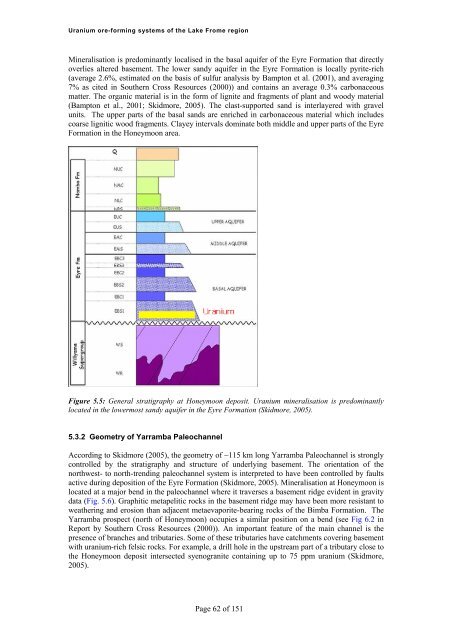Uranium ore-forming systems of the - Geoscience Australia
Uranium ore-forming systems of the - Geoscience Australia
Uranium ore-forming systems of the - Geoscience Australia
You also want an ePaper? Increase the reach of your titles
YUMPU automatically turns print PDFs into web optimized ePapers that Google loves.
<strong>Uranium</strong> <strong>ore</strong>-<strong>forming</strong> <strong>systems</strong> <strong>of</strong> <strong>the</strong> Lake Frome regionMineralisation is predominantly localised in <strong>the</strong> basal aquifer <strong>of</strong> <strong>the</strong> Eyre Formation that directlyoverlies altered basement. The lower sandy aquifer in <strong>the</strong> Eyre Formation is locally pyrite-rich(average 2.6%, estimated on <strong>the</strong> basis <strong>of</strong> sulfur analysis by Bampton et al. (2001), and averaging7% as cited in Sou<strong>the</strong>rn Cross Resources (2000)) and contains an average 0.3% carbonaceousmatter. The organic material is in <strong>the</strong> form <strong>of</strong> lignite and fragments <strong>of</strong> plant and woody material(Bampton et al., 2001; Skidm<strong>ore</strong>, 2005). The clast-supported sand is interlayered with gravelunits. The upper parts <strong>of</strong> <strong>the</strong> basal sands are enriched in carbonaceous material which includescoarse lignitic wood fragments. Clayey intervals dominate both middle and upper parts <strong>of</strong> <strong>the</strong> EyreFormation in <strong>the</strong> Honeymoon area.Figure 5.5: General stratigraphy at Honeymoon deposit. <strong>Uranium</strong> mineralisation is predominantlylocated in <strong>the</strong> lowermost sandy aquifer in <strong>the</strong> Eyre Formation (Skidm<strong>ore</strong>, 2005).5.3.2 Geometry <strong>of</strong> Yarramba PaleochannelAccording to Skidm<strong>ore</strong> (2005), <strong>the</strong> geometry <strong>of</strong> ~115 km long Yarramba Paleochannel is stronglycontrolled by <strong>the</strong> stratigraphy and structure <strong>of</strong> underlying basement. The orientation <strong>of</strong> <strong>the</strong>northwest- to north-trending paleochannel system is interpreted to have been controlled by faultsactive during deposition <strong>of</strong> <strong>the</strong> Eyre Formation (Skidm<strong>ore</strong>, 2005). Mineralisation at Honeymoon islocated at a major bend in <strong>the</strong> paleochannel where it traverses a basement ridge evident in gravitydata (Fig. 5.6). Graphitic metapelitic rocks in <strong>the</strong> basement ridge may have been m<strong>ore</strong> resistant towea<strong>the</strong>ring and erosion than adjacent metaevaporite-bearing rocks <strong>of</strong> <strong>the</strong> Bimba Formation. TheYarramba prospect (north <strong>of</strong> Honeymoon) occupies a similar position on a bend (see Fig 6.2 inReport by Sou<strong>the</strong>rn Cross Resources (2000)). An important feature <strong>of</strong> <strong>the</strong> main channel is <strong>the</strong>presence <strong>of</strong> branches and tributaries. Some <strong>of</strong> <strong>the</strong>se tributaries have catchments covering basementwith uranium-rich felsic rocks. For example, a drill hole in <strong>the</strong> upstream part <strong>of</strong> a tributary close to<strong>the</strong> Honeymoon deposit intersected syenogranite containing up to 75 ppm uranium (Skidm<strong>ore</strong>,2005).Page 62 <strong>of</strong> 151
















